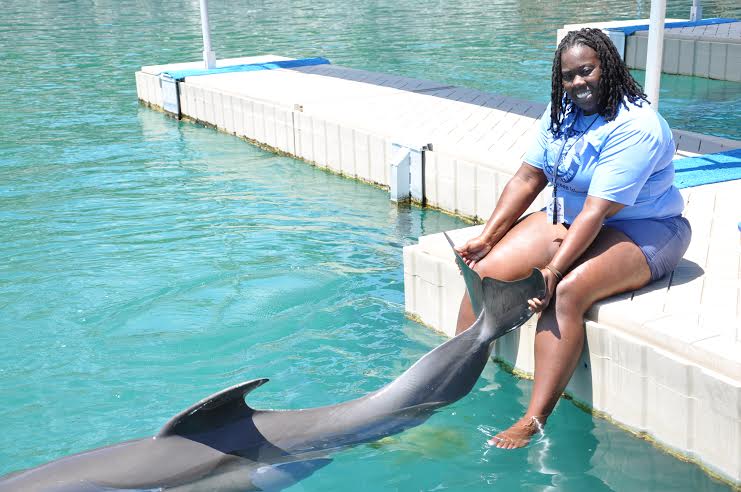The Dolphin Encounters team likes to ensure that each and every one of its visitors has a fantastic experience while in their hands (or fins). So, while the trainers, dolphins and sea lions are interacting with our visitors, a lot goes on in the background to make sure every animal is fit, healthy and happy.
Known as “animal husbandry”, the practice of caring for the dolphins and sea lions at Dolphin Encounters involves an array of procedures for monitoring each animal’s health. Dolphin Encounters Director of Marine Mammals Kim Brewer Terrell has been with the Dolphin Encounters team for 18 years. With a bachelor’s degree in zoology, 31 years’ experience in training and 29 years’ experience in managing marine mammals, she knows her stuff when it comes to animal husbandry.
Understanding how important it is to think about the small details, under her leadership, the Dolphin Encounters team employs methods of tracking and maintaining animal wellness, ranging from obtaining fecal and stomach samples to giving eye drops. To do all of this, the Dolphin Encounters staff have implemented a structured routine of medical examinations and consistent observations. Each observation is logged and recorded, and every animal has his or her own medical history.
With different bodies and a language barrier, medical examinations could get a bit difficult. That’s why one of the first things the dolphins and sea lions in Dolphin Encounters’ care learn is a set of behaviors for check-ups. One of the most important behaviors is a fluke presentation. All dolphins and sea lions at Dolphin Encounters know how to present their flukes and flippers, respectively, to trainers for temporary holding; this is necessary because blood is drawn from the underside of dolphins’ flukes and sea lions’ flippers. Much like regular human check-ups, which often involve blood testing, dolphin and sea lions’ blood needs to be screened for the early detection of illnesses.
Extra precautions – like crate training sea lions to allow for easy movement in the event of an emergency. The animals are screened and visited by a veterinarian four times a year.
Training dolphins and sea lions to participate in health check-ups by presenting their flukes and flippers and actively participating in other screenings like ultrasounds takes some time. The Dolphin Encounters team employs a training method using positive reinforcement through operant conditioning; this means that animals are trained step by step by following a ‘target’. Each correct step results in a reward for the animal – a treat, toy or attention – and each incorrect step results in a neutral response or a time-out for five seconds or more.
The hard work has paid off in more ways than one; training means that each animal’s wellness can be safeguarded and caregivers can develop closer and trusting relationships with their charges.


